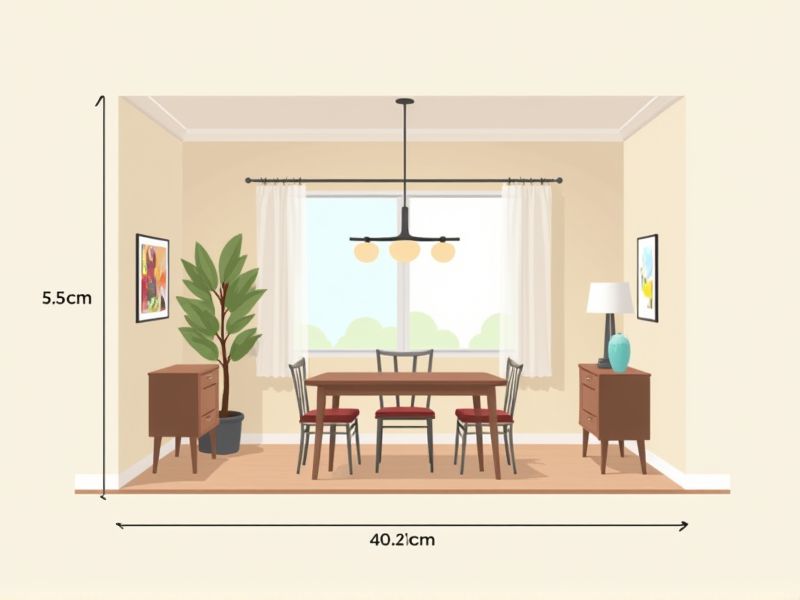
When planning a dining room, the standard dimensions can help you create a comfortable and functional space. Most dining rooms are typically 12 feet by 14 feet (about 3.6 meters by 4.2 meters), which allows for a dining table, chairs, and adequate movement around the furniture. For smaller homes or apartments, a dining area can work within 10 feet by 12 feet (around 3 meters by 3.6 meters). When deciding on your layout, also consider clearance space--a minimum of 36 inches (91 cm) from the edge of the table to the wall or furniture is recommended so guests can move their chairs easily.
Room Size Requirements
For an optimal dining experience, your dining room should ideally measure at least 10 by 12 feet, accommodating a standard table size of 6 to 8 seats comfortably. Allowing for 36 inches of walking space around the table ensures easy movement and accessibility. In larger spaces, consider a table length of 72 to 96 inches to enhance functionality without sacrificing comfort. Proper lighting, at a height of 30 to 36 inches above the table, can further elevate your dining ambiance while highlighting your room's dimensions.
Table Shape Considerations
When selecting a dining room table, consider the shape to optimize space and functionality. Rectangular tables, typically measuring 72 to 96 inches in length, accommodate larger groups, making them ideal for family gatherings. Round tables, with diameters ranging from 36 to 72 inches, foster intimacy for smaller settings and facilitate easy conversation. Square tables, often 36 to 60 inches per side, are versatile for both small and large spaces, ensuring a balanced aesthetic in your dining area.
Minimum Door Clearance
A minimum door clearance of 32 inches is essential for dining room accessibility, ensuring easy entry and exit without obstruction. This standard accommodates wheelchairs and large furniture, enhancing overall usability. Maintaining a clear path helps promote a comfortable dining environment, allowing guests to move freely. Therefore, prioritizing this space can significantly improve the dining experience for everyone involved.
Seating Space Per Person
In a well-designed dining room, the standard allocation of seating space is typically 24 to 30 inches per person to ensure comfort. This arrangement allows for easy movement and accessibility while dining. For a table accommodating six diners, a rectangular table measuring at least 72 inches in length provides optimal space. Prioritizing this standard not only enhances your dining experience but also promotes a welcoming atmosphere for gatherings.
Ideal Ceiling Height
An ideal dining room ceiling height typically ranges between 9 to 10 feet, creating an open and spacious feel that enhances the dining experience. This height allows for ample light fixture options, such as chandeliers, which can become a focal point in the room. With 9-foot ceilings, a well-proportioned dining table can comfortably accommodate 6 to 8 diners, ensuring an inviting atmosphere. Proper ceiling height also contributes to improved acoustics, allowing for enjoyable conversations during meals.
Walkway Clearance
The standard walkway clearance in a dining room should ideally measure at least 36 inches (91 cm) to ensure comfortable movement around furniture. This space allows easy access to dining chairs, enabling guests to sit and rise without obstruction. For optimal flow, ensure an additional 24 to 30 inches (61 to 76 cm) of clearance is provided between the edge of the dining table and adjacent walls or fixtures. Proper walkway clearance enhances the overall dining experience by reducing congestion and facilitating smooth interactions during meals.
Furniture Layout Planning
Furniture layout planning in a dining room significantly impacts both functionality and aesthetics, making it essential for an inviting atmosphere. Optimal arrangement typically includes a dining table, ideally measuring 72 to 96 inches for accommodating six to eight people comfortably, which should be centered within the space. Ensure a minimum of 36 inches of clearance around the table to facilitate movement and enhance accessibility. Consider incorporating sideboards or buffets, approximately 42 inches high, for additional storage and serving options while maintaining a balanced visual appeal.
Chair Spacing Guidelines
Chair spacing in a dining room is essential for comfort and functionality, with a widely recommended guideline of 24 to 30 inches between the center points of each chair. This spacing allows diners to move in and out easily, accommodating different body sizes and preferences. For a standard table size of 60 inches by 72 inches, you can effectively seat six to eight people, ensuring each guest feels comfortable without the risk of bumping into one another. Proper chair spacing not only enhances the dining experience but also contributes to an aesthetically pleasing arrangement in your dining area.
Lighting Fixture Placement
Proper lighting fixture placement in your dining room enhances both functionality and ambiance. Aim to center the main fixture, such as a chandelier or pendant light, approximately 30 to 36 inches above the dining table, accommodating a standard table height of 28 to 30 inches. For larger spaces, consider multiple light sources like wall sconces or recessed lighting, which can create a layered effect and improve overall illumination. Remember to choose fixtures that are proportional to the room size; a fixture that is too small may get lost in the space, while one that is too large can overwhelm the area.
Buffet Or Sideboard Allowance
A dining room buffet or sideboard typically ranges from 60 to 72 inches in length, providing ample storage for dishes, glassware, and linens. When considering your space, aim for a height of 30 to 36 inches to ensure easy access to items without sacrificing style. A well-placed buffet can enhance your dining experience, allowing you to serve meals efficiently while keeping your dining area organized. Incorporating this piece can also elevate the aesthetic appeal of your room, offering opportunities for personal decor and seasonal displays.
